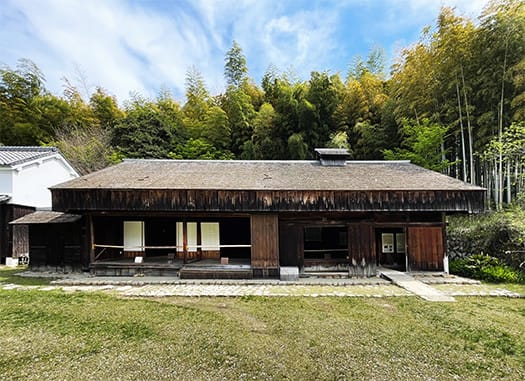


写真の家は大阪豊中の民家園に移築保存された十津川の有力者として知られる「丸田家」。北海道人にとって「十津川」というのは、明治開拓期の象徴的な「入植」の動きとしての記憶が強烈です。「新十津川」という入植した土地の地名が、いかにも母なる土地への「思い」を心に響かせてくる。2年ほど前に北海道人には非常に縁遠い「熊野詣」を果たしたとき、そこから大和平野・明日香方面に抜けてきた道中で「ここが新十津川の母村か……」と心理に残響し続けてきていた。三千六百峰と冠詞表現されるほどの深い山地と渓谷の自然環境。
しかし十津川は、その歴史の一端を知るだけでもその深みに驚かされる。平安末期1142年には古文書に「遠津川郷〜とおつかわごう」という地名が見られるという。遠津川という地名の意味は都からははるかに遠い吉野山地の彼方の地域という意味だと。とはいえ、それは山地と渓谷という自然環境の成せる技であって、距離的には奈良や京の都に近くまた、熊野三山という古来からの列島社会の信仰拠点を控えて、中央の文化が古くから浸透していた。南北朝期という時代の成立を見ても、非常に興味深い。政権中央での戦乱に敗れてのがれ住んだ人物家系も多く、そうした子孫を中心に「十津川郷士」と呼ばれる層がかたちづくられてもいる。
戦国末期の1588年の太閤検地によって十津川の領域が正式に認められる。しかし租税の基礎である水田がこの地域にはほとんどなく、畑作や林業などが生業であったことから赦免地として租税負担を免除されることになった。(石碑写真)司馬遼太郎「街道をゆく12 十津川街道」でも、この租税免除という伝統的な法制度体系がひとびとの意識に刷り込まれたDNAについて探究されている。
そのような地域的な特殊性からか、政治的な感受性は鋭敏で、徳川幕府成立期にはその特性が発揮されていちはやく徳川に与力してこの租税免除権は継続された。
わたし個人的な体感として、紀伊半島南部はながくその交通の不便さもあって訪れることがなかったのだけれど、一度このような訪問体験を持つと、今度は一転して無性に気になってしまう。
遠くて近い、そして近くて遠い。そのような地域印象の極地のようなのだ。
English version⬇
History of Totsukawa - to the end of the Edo period Totsukawa and ‘New Totsukawa’ - 3
The ‘annual tribute forgiveness’ tax exemption dating back to the Taikoh land survey. The extraterritorial history of the area encompassing the centre of power and the ‘near but far’ mountains and valleys, as well as the Kumano faith. ...
The house in the photograph is the ‘Maruta Family’, known as a prominent Totsukawa family, which has been relocated and preserved in the Minka-en in Toyonaka, Osaka. For Hokkaido people, ‘Totsukawa’ has a strong memory as a symbolic ‘settlement’ movement during the Meiji pioneering period. The name of the settled land, ‘Shin Totsukawa’, echoes in our minds how we ‘feel’ for the mother land: when I made a ‘Kumano Pilgrimage’ two years ago, which is very remote from Hokkaido people, on the way from there to the Yamato Plain and Asuka area, I thought ‘This is the mother village of Shin Totsukawa...’. The three thousand six hundred peaks and their crowns are the most important in the world. The natural environment of deep mountains and valleys is so deep that it is described by the article as ‘three thousand six hundred peaks’.
The depth of Totsukawa, however, is astonishing even if one only knows a part of its history. In 1142, at the end of the Heian period (794-1192), the place name ‘Tootsukawa-go’ is found in ancient documents. The meaning of the place name Tootsugawa is said to be that of an area far from the capital in the Yoshino Mountains. However, this was the result of the natural environment of the mountains and valleys, which were close to the capitals of Nara and Kyoto, and the Kumano Sanzan, an ancient centre of worship in the archipelago, where the culture of the centre had long permeated. The establishment of the period of the Northern and Southern Dynasties is also very interesting. Many families of people who were defeated in warfare at the centre of the regime fled to live in the area, and a group of people known as the ‘Totsukawa Goushi’ was formed around their descendants.
In 1588, at the end of the Warring States period, the territory of Totsukawa was officially recognised by the Taikō Kenshi. However, as there were few rice paddies, the basis for taxation, in the area and the people's livelihoods depended on field cultivation and forestry, the area was exempted from taxation as a pardoned area. (Stone monument photo) Ryotaro Shiba's Kaido yuku 12: Totsukawa Kaido also explores the DNA of this traditional legal system of tax exemption, which was imprinted on people's consciousness.
Perhaps because of such regional peculiarities, political sensitivities were keenly felt, and during the Tokugawa Shogunate's establishment period, this characteristic was demonstrated and this right to tax exemptions was continued as soon as the Tokugawa were given power.
I personally have not visited the southern part of the Kii Peninsula for a long time, partly because of its inconvenience in terms of transportation, but once I have had this experience of visiting the region, I have turned my attention to it.
It is both far and near, and near and far. It is like the polar opposite of the impression of the region.




























※コメント投稿者のブログIDはブログ作成者のみに通知されます